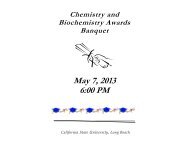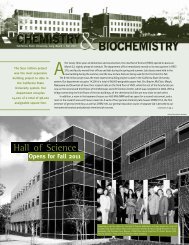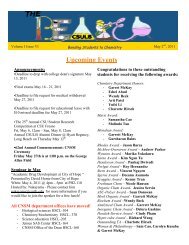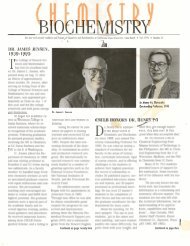2010 - California State University, Long Beach Department of ...
2010 - California State University, Long Beach Department of ...
2010 - California State University, Long Beach Department of ...
You also want an ePaper? Increase the reach of your titles
YUMPU automatically turns print PDFs into web optimized ePapers that Google loves.
Stephen Mezyk’s<br />
Radical Chemistry Benefits Society<br />
By Anne Ambrose<br />
Remediation <strong>of</strong> chemical contaminants in waters, elucidating aerosol chemistry in the<br />
atmosphere and even understanding the chemistry behind carcinogenesis have long been<br />
interests <strong>of</strong> Stephen Mezyk, pr<strong>of</strong>essor <strong>of</strong> physical and environmental chemistry, whose<br />
expertise in radical chemistry has earned international recognition. “I try to do chemistry that<br />
helps overcome some <strong>of</strong> the bigger problems in the world,” he said. Now, his RadKEM laboratory<br />
is turning its sights in a new direction, working to improve reprocessing methods for spent<br />
nuclear fuel in support <strong>of</strong> the many nations currently generating electricity through clean<br />
nuclear energy programs.<br />
The U.S. <strong>Department</strong> <strong>of</strong> Energy (DOE) recently named CSULB's Dr. Stephen Mezyk as the<br />
only principal investigator from a non-Ph.D.-granting institution among 23 universities to<br />
receive Nuclear Energy <strong>University</strong> Program <strong>2010</strong> funding for nuclear education and technologies.<br />
This four-year grant for $1.4 million was one <strong>of</strong> 13 Fuel Cycle Research and Development grants<br />
exploring methods for recycling and disposing <strong>of</strong> used fuel produced by nuclear power plants,<br />
and one <strong>of</strong> the largest <strong>of</strong> 42 university grants for nuclear research awarded by DOE this year. Dr.<br />
Mezyk will be working with the colleagues at the Idaho National Laboratory and <strong>University</strong> <strong>of</strong><br />
<strong>California</strong>, Irvine, on this project to explore the effects <strong>of</strong> radiolysis on the extraction ligands<br />
used to selectively recover radioactive nuclides from dissolved spent fuel. The project will examine<br />
the chemistry behind the alpha and gamma radiation-induced degradation <strong>of</strong> these ligands<br />
under anticipated reprocessing conditions. Dr. Mezyk's research is ultimately aimed at understanding<br />
the fundamental mechanisms <strong>of</strong> radiation damage that occurs, thus allowing for<br />
improved isotope recycling efficiency and reduction <strong>of</strong> high-level radioactive waste.<br />
Dr. Mezyk, who joined CSULB in 2001, earned his B.Sc. and Ph.D. from the <strong>University</strong> <strong>of</strong><br />
Melbourne, Australia. He is an associate editor <strong>of</strong> the Journal <strong>of</strong> Advanced Oxidation Technologies<br />
and has received multiple research grants and contracts, particularly for his water chemistry<br />
studies. This spring, he received the CSULB Provost’s <strong>2010</strong> Award for Impact Accomplishment <strong>of</strong><br />
the Year in Research, Scholarly and Creative Activity, following his CSULB Distinguished Faculty<br />
Scholarly and Creative Achievement Award in 2008.<br />
In addition to his research accomplishments, Dr. Mezyk is also a respected teacher and<br />
mentor. He received the CSULB <strong>University</strong> Distinguished Faculty Teaching Award in 2007 and,<br />
over the past nine years, has mentored his RadKEM research students to pursue careers in medicine,<br />
veterinary and doctoral research programs. His students have had extensive experience at<br />
working at state-<strong>of</strong>-the-art <strong>Department</strong> <strong>of</strong> Energy national laboratories, writing scientific papers<br />
published in such prestigious journals as Environmental Science and Technology, Radiation<br />
Research, Journal <strong>of</strong> Physical Chemistry, Water Research and Environmental Chemistry. Many <strong>of</strong><br />
his students have presented their research in talks at national and international conferences, and<br />
obtained their own research funding from outstanding organizations including the Arnold Beckmann<br />
Foundation, CSULB’s Women and Philanthropy, Phi Beta Kappa and the Orange County<br />
Water District. He also recently appeared as an expert in water and nuclear chemistry in the<br />
award-winning video series, Understanding Chemistry in Your World, by Coast Learning Systems.<br />
New <strong>Department</strong><br />
Website<br />
By Dr. Eric J. Sorin,<br />
Web Page Committee Chair<br />
Iam happy to announce that the new<br />
<strong>Department</strong> <strong>of</strong> Chemistry and Biochemistry<br />
website will, by the time <strong>of</strong> this publication,<br />
be fully functional and fully accessible to the<br />
general public. The Web Page Committee has<br />
spent considerable time redesigning the website<br />
to dramatically improve the overall visual<br />
appeal, organizational flow and ease <strong>of</strong> navigation.<br />
Most notably, users will now see a<br />
much stronger focus on the research taking<br />
place within the department and the sense <strong>of</strong><br />
community that exists within our college.<br />
Among the many changes that have been<br />
made, the new homepage now includes a<br />
modern flash banner with a continuously<br />
rotating panel that highlights areas <strong>of</strong> active<br />
research within the department. The homepage<br />
also dons a new “<strong>Department</strong> News” column<br />
and an interactive calendar that will minimize<br />
the amount <strong>of</strong> navigation needed to keep up<br />
with department, college and university events.<br />
The links menu has been replaced with a much<br />
more concise horizontal drop-down menu,<br />
thereby consuming less screen space and simplifying<br />
the navigation process. Within the<br />
“People” and “Research” menus, you will find<br />
several new options to access departmental<br />
information, including new categories to<br />
describe the research each faculty member<br />
is pursuing.<br />
Our goals were simple: modernize the aesthetics<br />
<strong>of</strong> the website, make navigation simple<br />
and expose the Internet community to information<br />
on our academic programs, research<br />
activities and community atmosphere as accurately<br />
as possible. With many contributions and<br />
suggestions from members <strong>of</strong> the department,<br />
we feel we have accomplished these goals and<br />
look forward to the continued maturation <strong>of</strong><br />
our new website, which serves as the international<br />
portal into the heart <strong>of</strong> our department.<br />
Please visit us at http://chemistry.csulb.edu and<br />
get to know the new department website!<br />
Web Page Committee members are Drs.<br />
Paul Buonora, Vas Narayanaswami,<br />
Young Shon, Paul Weers, and graduate<br />
students Emel Adaligil and<br />
Tommy Neubauer.<br />
7



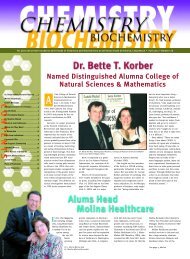
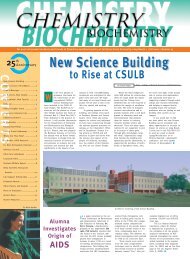
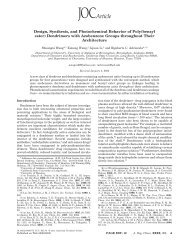
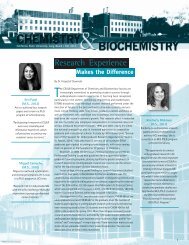
![Volume 4, Issue 3 [November 2012 pdf] - California State University ...](https://img.yumpu.com/34605825/1/190x245/volume-4-issue-3-november-2012-pdf-california-state-university-.jpg?quality=85)
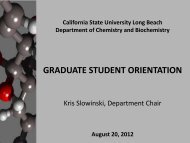
![Volume 5, Issue 2 [April 2013 pdf] - California State University, Long ...](https://img.yumpu.com/33273195/1/190x245/volume-5-issue-2-april-2013-pdf-california-state-university-long-.jpg?quality=85)
